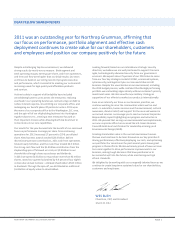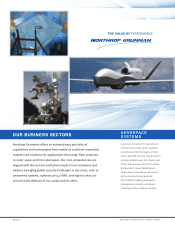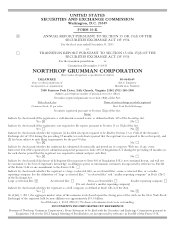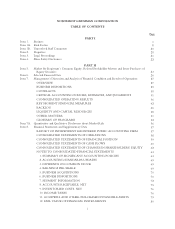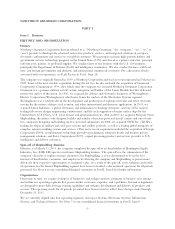Northrop Grumman 2011 Annual Report Download - page 13
Download and view the complete annual report
Please find page 13 of the 2011 Northrop Grumman annual report below. You can navigate through the pages in the report by either clicking on the pages listed below, or by using the keyword search tool below to find specific information within the annual report.NORTHROP GRUMMAN CORPORATION
The division also provides integrated electronic warfare capability, communications, and intelligence systems;
unattended ground sensors; automatic test equipment; and advanced threat simulators. Key programs include the
U.S. Marine Corps Ground/Air Task Oriented Radar (G/ATOR) multi-mission radar; the Large Aircraft Infrared
Countermeasures (LAIRCM) system for the U.S. Air Force, U.S. Navy, and strategic international and NATO
allies; the AN/ALQ-131(V) electronic countermeasures pod; the LR-100 high-performance radar warning
receiver (RWR)/electronic support measures (ESM)/electronic intelligence (ELINT) receiver system; the U.S.
Army’s STARLite Synthetic Aperture Radar for Unmanned Aerial Vehicles (UAVs); the U.S. Army Vehicle
Intercom Systems (VIC-3 and VIC-5); the U.S. Army Next Generation Automated Test System (NGATS); the
U.S. Air Force Joint Threat Emitter (JTE) training range system; and the Vehicle and Dismount Exploitation
Radar (VADER) system that enable airborne platforms to track individual persons or vehicles.
Naval & Marine Systems – delivers products and services to defense, civil, and commercial customers supporting
smart navigation, shipboard radar surveillance, ship control, machinery control, integrated combat management
systems for naval surface ships, high-resolution undersea sensors (for mine hunting, situational awareness, and other
applications), unmanned marine vehicles, shipboard missile and encapsulated payload launch systems, propulsion
and power generation systems, and nuclear reactor instrumentation and control. Key products include Integrated
Bridge and Navigation Systems, Voyage Management System, Integrated Platform Management Systems,
Integrated Combat Management System, AN/WSN-7 Inertial Navigator, anti-ship missile defense and
surveillance radars (Cobra Judy, AN/SPQ-9B, AN/SPS-74), propulsion equipment, missile launch, and sonar
systems for the Virginia-class submarine, and launch system support for the Ohio-class submarine.
Navigation Systems – delivers products and services to defense, civil, and commercial customers supporting
situational awareness, inertial navigation in all domains (air, land, sea, and space), embedded Global Positioning
Systems, Identification Friend or Foe (IFF) systems, acoustic sensors, cockpit video monitors, mission computing,
and integrated avionics and electronics systems. Key products include the Integrated Avionics System, the
AN/TYQ-23 Aircraft Command and Control System, Fiber Optic Acoustic Sensors, and a robust portfolio of
inertial sensors and navigation systems.
Targeting Systems – delivers products and services supporting airborne combat avionics (fire control radars, multi-
function apertures and pods), airborne electro-optical/infrared targeting systems, and laser/electro-optical systems
including hand-held, tripod-mounted, and ground or air vehicle mounted systems. Key products include fire
control radars for the B-1B, F-16 (worldwide), F-22 U.S. Air Force, and F-35; AN/APN-241 navigation/weather
radar; the AN/AAQ-28(V) LITENING family of targeting pods; Distributed Aperture EO/IR systems; and the
Lightweight Laser Designator Rangefinder (LLDR).
In addition to the product and service lines discussed above, the Electronic Systems segment also includes the
Advanced Concepts & Technologies Division (AC&TD), which develops next-generation systems and
architectures to position the segment in key developing markets. AC&TD focuses on understanding customer
mission needs; conceiving affordable, innovative and open solutions; and demonstrating the readiness and
effectiveness of Electronic Systems’ products, including all types of sensors, microsystems, and associated
information systems. The segment uses a “Product Ownership” approach, which guides the transition of new
technology from laboratory to market and implements modular open system product families that are readily
reconfigurable and scalable to affordably support new requirements, new products, or component obsolescence.
INFORMATION SYSTEMS
Information Systems, headquartered in McLean, Virginia, is a leading provider of advanced solutions for the DoD,
national intelligence, federal civilian, state and local agencies, and commercial and international customers.
Products and services focus on the fields of command, control, communications, computers (C4) and intelligence;
airborne reconnaissance; intelligence processing; air and missile defense; decision support systems; cybersecurity;
information technology; and systems engineering and integration. The segment consists of three business areas:
Defense Systems; Intelligence Systems; and Civil Systems.
-3-


